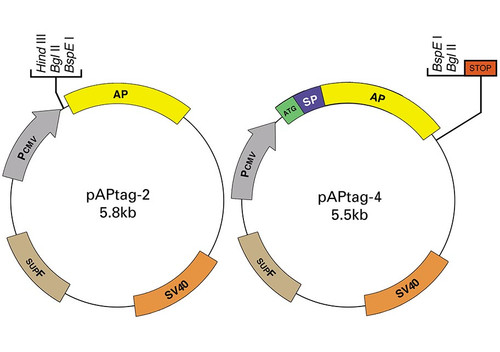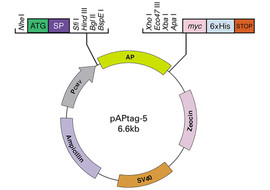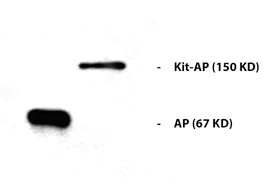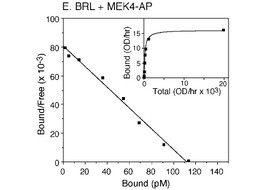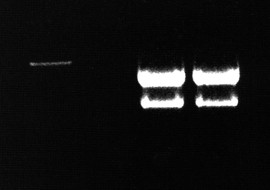- Home
- AP-TAG
- AP-TAG Vectors & Kits
- AP-TAG Kit A
AP-TAG Kit A
Product Description
For non-radioactive detection of receptor/ligand interaction.
This is the second generation of AP-TAG technology using pAPtag-2 and pAPtag-4 vectors. A secreted ligand or soluble receptor can be fused with secreted alkaline phosphatase (AP) at either its N- or C-terminus to produce an "AP-body". The resulting AP fusion protein can be expressed as a secreted protein and used directly as highly sensitive affinity agents much like an antibody.
| AP-TAG Kit A | |
| pAPtag-2 (10 µg) | 40 µL |
| pAPtag-4 (10 µg) | 40 µL |
| L-AP primer (2 µM) | 100 µL |
| R-AP primer (2 µM) | 100 µL |
| Colony lysis buffer | 2 x 1 mL |
| Features | pAPtag-2 | pAPtag-4 |
| Size (kb) | 5.8 | 5.5 |
| AP fusion type | Ligand-AP (Receptor-AP) | AP-Ligand (AP-Receptor) |
| Cloning sites | Hind III, Bgl II, BspE I | Bgl II, BspE I |
| Promoter | CMV | CMV |
| SV40 Ori. |
Yes | Yes |
| E. coli host |
GH2/P3 | GH2/P3 |
| Vector selection |
Tet/Amp | Tet/Amp |
| Secretion signal |
From insert | From AP |
|
AP negative control (secretes AP alone) |
No | Yes |
NOTE: pAPtag-2 and pAPtag-4 plasmid vectors can only be transformed or propagated in E. coli host cells with P3 episome such as GH2/P3 Supercompetent cells (Cat. No. T601).
The L(left)- and R(right)-AP primers flanking the cloning sites of pAPtag-2 are used in PCR to check for the presence and size of DNA insert cloned into the vector and for sequence verification of the Ligand-AP or soluble receptor-AP fusion constructs. The L-AP4 and R-AP4 primers (not included in kit) flank the cloning sites of pAPtag-4 and can be purchased separately (see below).
This kit is shipped on dry ice via overnight delivery. A detailed step-by-step protocol is included.
Purchase of an AP-TAG Ligand-Receptor Interaction Detection System (covered by US patents 5,554,499 and 5,801,000) comes with a limited, single-user and non-transferable sublicense for use in research applications only. If you plan to use AP-TAG technology to conduct drug screening or other commercial applications, a separate sublicense is required. Please contact GenHunter for details regarding the terms and conditions or any other questions.
References:
- Flanagan, J. G. and Leder, P. (1990). The kit Ligand: A cell surface molecule altered in steel mutant fibroblasts. Cell 63, 185-194.
- Cheng, H.J., and Flanagan, J.G. (1994). Identification and cloning of ELF-1, a developmentaly expressed ligand for Mek4 and Sek receptor tyrosine kinases. Cell 79, 157-168.
- Tartaglia, L.A. et al. (1995). Identification and expression cloning of a leptin receptor, OB-R. Cell 83, 1263-1271.
- He, Z. and Tessier-Lavigne, M. (1997). Neuropilin is a receptor for the axonal chemorepellent Semaphorin III. Cell 90, 739-751.
- Flanagan, J.G., et al. (2000). Alkaline phosphatase fusions of ligands or receptors as in situ probes for staining of cells, tissues and embryos. Methods in Enzymology 327, 17-35.
- Flanagan, J.G., and Cheng, H.-J. (2000). Alkaline phosphatase fusion proteins for molecular characterization and cloning of ligands and receptors. Methods in Enzymology 327, 198-210.
- US patents 5,554,499 and 5,801,000
| Description | Volume |
Cat. No. (Academic) |
Cat. No. (Industry) |
| pAPtag-2 (10 µg) | 40 µL | QV2 | QV2P |
| pAPtag-4 (10 µg) | 40 µL | QV4 | QV4P |
| L-AP primer (2 µM) | 100 µL | Q210 | Q210 |
| R-AP primer (2 µM) | 100 µL | Q211 | Q211 |
| L-AP4 primer (2 µM) | 100 µL | Q213 | Q213 |
| R-AP4 primer (2 µM) | 100 µL | Q214 | Q214 |
| Colony Lysis Buffer | 5 mL | L102 | L102 |
| AP-TAG Kit A | |
| pAPtag-2 (10 µg) | 40 µL |
| pAPtag-4 (10 µg) | 40 µL |
| L-AP primer (2 µM) | 100 µL |
| R-AP primer (2 µM) | 100 µL |
| Colony lysis buffer | 2 x 1 mL |
| Features | pAPtag-2 | pAPtag-4 |
| Size (kb) | 5.8 | 5.5 |
| AP fusion type | Ligand-AP (Receptor-AP) | AP-Ligand (AP-Receptor) |
| Cloning sites | Hind III, Bgl II, BspE I | Bgl II, BspE I |
| Promoter | CMV | CMV |
| SV40 Ori. |
Yes | Yes |
| E. coli host |
GH2/P3 | GH2/P3 |
| Vector selection |
Tet/Amp | Tet/Amp |
| Secretion signal |
From insert | From AP |
|
AP negative control (secretes AP alone) |
No | Yes |
AP-TAG Kit A - Cat. No. Q201 (for Academic/Non-profit institutions)
AP-TAG Kit A - Cat. No. Q201P (for Industry)
Purchase of an AP-TAG Ligand-Receptor Interaction Detection System (covered by US patents 5,554,499 and 5,801,000) comes with a limited, single-user and non-transferable sublicense for use in research applications only. If you plan to use AP-TAG technology to conduct drug screening or other commercial applications, a separate sublicense is required. Please contact GenHunter for details regarding the terms and conditions or any other questions.
| Description | Volume |
Cat. No. (Academic) |
Cat. No. (Industry) |
| pAPtag-2 (10 µg) | 40 µL | QV2 | QV2P |
| pAPtag-4 (10 µg) | 40 µL | QV4 | QV4P |
| L-AP primer (2 µM) | 100 µL | Q210 | Q210 |
| R-AP primer (2 µM) | 100 µL | Q211 | Q211 |
| L-AP4 primer (2 µM) | 100 µL | Q213 | Q213 |
| R-AP4 primer (2 µM) | 100 µL | Q214 | Q214 |
| Colony Lysis Buffer | 5 mL | L102 | L102 |
We also offer the AP-TAG Kit B (Q202) with the pAPtag-5 vector.
 Loading... Please wait...
Loading... Please wait...


